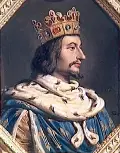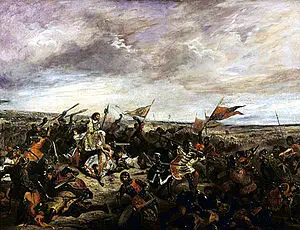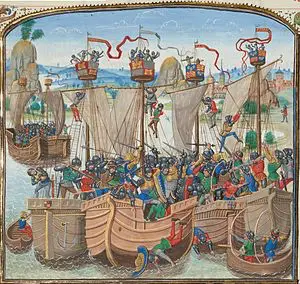The French King Charles V
Charles V was king of France during the Hundred Years War. He was known for his significant victories, turning the tide after a series of major English victories. 
He was born on Jan. 21, 1338, in Vincennes. His father was John, who at the time was the heir to the throne and in 1350 became King John II. Charles's mother was Bonne of Bohemia, whom the Black Death claimed in 1349. A very smart boy, Charles had a courtly education, along with a handful of his brothers; Charles was, however, not strong of physical constitution. In 1349, Charles became the first to be named dauphin, the official title of the heir apparent and the nominal ruler of the area known as the Dauphiné, in what is now southeast France. On April 8, 1350, he married his cousin Joanna of Bourbon. The marriage took place in private because Charles had been seriously ill for several months beforehand. They had nine children, three of whom reached adulthood: Charles, Louis, and Catherine. One of John's prime opponents during his reign was another Frenchman, Charles of Navarre. (Some sources refer to John the Good and Charles the Bad.) Charles was a wealthy and powerful baron who had many supporters. In 1354, during a pause in the fighting, he killed King John's favorite advisor, Charles de la Cerda. Going further, Charles of Navarre secretly negotiated a treaty with England that would have given him half of France if he had helped England win the war. In an act of deft diplomacy, Charles, the dauphin, convinced his father and Charles of Navarre to patch up their differences. The dauphin also set about shoring up the defenses of Normandy, anticipating another French attack. 
Fighting between England and France resumed in 1356, and the English claimed another victory. Edward, the Black Prince ranged through the French countryside, pursued by John II. The two armies met near Poitiers on Sept. 19, 1356, and the Black Prince again showed his military mettle. Again, French forces outnumbered English forces. Again, England more than made up for this deficit with the devastating power of the longbow and the cannon. King John II had left his main force of infantry behind because he wanted to catch up to Edward and thought that the main infantry, which numbered 20,000, would slow him down. After a series of attacks and counterattacks, a well timed cavalry charge by the English turned the corner on the French left and turned the struggle into a rout. The English victory was so complete that English forces captured the French king himself and several hundred members of the French aristocracy. The capture of John occurred despite the fact that he and 17 knights from his personal guard dressed exactly the same. Charles led a battalion during this battle and survived intact and uncaptured. Edward, the Black Prince treated King John like the royalty that he was, serving him a royal meal in the Black Prince's personal tent. Then, a royal guard escorted John to England, where he was held in a series of places while the terms of his ransom were negotiated. A treaty in May 1360 set his ransom at 3 million crowns (a very large amount of money in those days). Meanwhile, Charles served as regent and called the Estates-General, with the intent of authorizing new taxes to pay for the prosecution of the war. In a particular act of self-interest, the Estates-General instead presented Charles with a kind of bill of rights, giving themselves the right to assemble whenever they wanted to, not when summoned. Charles, thinking that he had no choice if he wanted his taxes approved, signed the Grand Ordinance; King John, however, refused to enact it. England's Kind Edward III allowed John to return to France on the promise that he would raise the necessary funds in order to pay the ransom; as proof of his commitment, John agreed that his second-oldest son, Louis of Anjou, would be a replacement hostage. Louis was kept in Calais, on English-occupied French soil, not in England itself. After three years in captivity, Louis had had enough of being a replacement hostage and escaped. John agreed to return to England and resume his captivity. He was there for only a few months before contracting an unknown illness. He died in Savoy Palace on April 8, 1364, having never raised his ransom. On that day, Charles became King Charles V. Seizing the initiative, Charles embarked on twin military initiatives of targeting his enemies foreign and domestic. He commissioned the military leader Bertrand du Guesclin to dispose of Charles of Navarre once and for all. Du Guesclin did so in short order at Cocherel. 
The English-French peace lasted for a few years, during which time both countries looked within. In 1369, the fighting was on again. England and France were on opposite sides of a dispute over the throne of Castile. The English devastated swathes of the French countryside; France responded by harrying some ports on England's south coast. In the 1372 Battle of La Rochelle, France regained control of the English Channel. The French followed that up with a low-level invasion of England, sacking the Isle of Wight and then a handful of towns in the southeast, including Hastings. France invaded Aquitaine again, completing the takeover in 1375, thus regaining all of the territory lost as part of the treaty that John II had signed after the disaster at Poitiers. England at the time was consumed by the waning of King Edward III and didn't respond in an effective way. Edward died in 1377 and was replaced by his grandson, who became Richard II. Charles, meanwhile, looked to consolidate his gains, which were substantial. Having long suffered from ill health, Charles in 1380 encountered an illness that he couldn't survive. He died on Sept. 16, 1380. Succeeding him was his oldest surviving son, who became Charles VI. Charles V was known as Charles the Wise because of his intellectual and religious zeal. His efforts at reorganizing the army and creating a new navy paid huge dividends in French gains on the battlefield. He solidified his borders by cementing alliances with nobles and rulers in Flanders, Portugal, and Spain. And, he made sure to spend money on improvements to well-known buildings and landmarks, including the Bastille and the Louvre. |
|
Social Studies for Kids
copyright 2002–2024
David White




